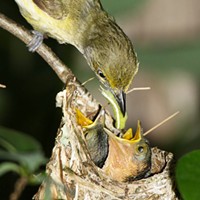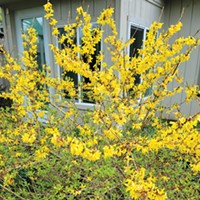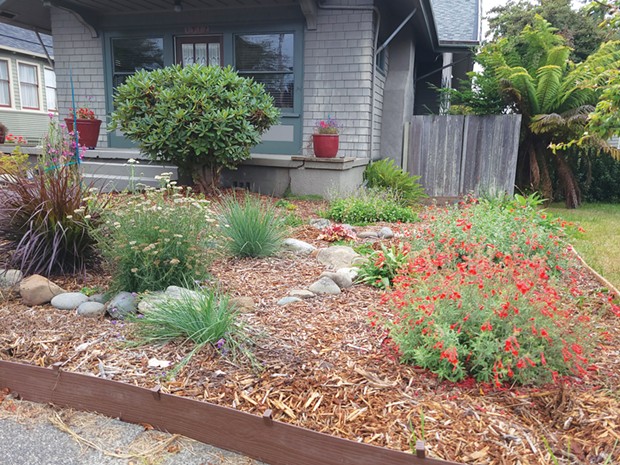[
{
"name": "Top Stories Video Pair",
"insertPoint": "7",
"component": "17087298",
"parentWrapperClass": "fdn-ads-inline-content-block",
"requiredCountToDisplay": "1"
}
]
As we approach the autumnal equinox, there are plenty of things to do in your garden. Sure, the calendar says that summer is coming to an end, but we often get some of the nicest and warmest weather in September and October here on the coast. What things should you think about as the days get shorter?
Watering. Your shrubs, trees and flowers are very thirsty, since we've had very little rain so far, which is typical for our area. The general rule is about an inch of "rain" per week. Consider using drip or soaker hoses, as overhead watering wastes a lot of water due to evaporation.
Deadhead some of those perennials. But not all! This is the time of year when migrating birds are searching out food sources and those dried seedheads make an excellent snack for many birds. I've watched chickadees, nuthatches and white-crowned sparrows picking over the seeds on my spent flowers out in the yard and down in the garden. It looks a little messy but the wildlife will thank you.
Clean up spent veggies and vines. Perhaps the four zucchini you planted (what were you THINKING?) are finishing with production and your neighbors don't want any more summer squash tossed into their open car window — perhaps they installed a camera on the front porch to catch the squash dumper in the act. Time to compost those old, tired plants.
Don't shear the herbs just yet! Here in my kitchen garden, the oregano, thyme and mint are all blooming. Those blooms feed a lot of pollinators, including the well-known and popular honeybee, but many others as well. Did you know California is home to more than 1,600 native bee species and several hundred other native pollinator species, such as parasitic wasps? Which brings me to ...
Plant! Fall is a great time to put in shrubs, perennials and trees. Keep them well watered until the winter rains start, and they'll develop a strong root system over the winter. Personally, I'm a big fan (and becoming an even bigger one) of native plants. Why? Because they're well adapted to our area and climate and feed the aforementioned pollinators. Native pollinators are about 100 times more efficient in pollination than honeybees are and they're in big trouble. Many people know that honeybees are in peril, but native pollinators are in much more dire straits, due to loss of habitat and the overuse (or any use at all) of pesticides and herbicides. But there's a way to get those insects some help. How? Well, I'm glad you asked.
Plant native plants! My team recently completed a 99 percent native plant installation on H street in Eureka. Not exactly an area close to wildlands, but the number of pollinators that showed up once the plants started blooming was astonishing to see. The plants grew quickly and are all in full bloom, which is a pretty good return on something planted just last May.
If you're unsure what will do well in your area, there's a handy link you can use to input your address or general area, and it will show you all the plants that do well in your particular zone. Just go to Calscape.org and type in your ZIP code or address. There are 7,972 plants that are native to California, and when I type in Humboldt Hill, which is closest to me geographically, I can see that there are 520 native plants that will do very well here in my yard. That's a lot of plants. Of course, you want to select plants that won't eat your entire yard or landscape, so it's a good idea to read what the plant's growth habit will be. For example, I'm a huge fan of Ceanothus 'Dark Star,' which is a hybrid of two other native Ceanothus species. But it will get up to 6-8 feet tall, and 8-12 feet wide. Although, I always tell clients that they need to add 20-25 percent to any plant tag information because things tend to grow a lot bigger here in Humboldt.
If you're ready to take the plunge into the wonderful world of native plants and pollinators, you're in luck. The local chapter of the California Native Plant Society (CNPS) is having their fall sale on the weekend of Sept. 23-24. I'm not sure if there will be slots left to sign up for by the time you read this, but you can stop by and inquire at the entrance to see if you can sneak in later in the day. Be sure to bring your own boxes to haul away all those lovely plants.
One word of caution about native plants: More than a few die back during the winter, so you may wonder what happened to your plant. Don't freak out, it's still there, it's just taking a nap. California fuchsia is a good example of a native perennial that goes dormant.
Another bonus of installing native plants in your yard is that once they become established, they need little to no supplemental water. Given the increase in water costs locally, this can not only beautify your yard, but save you money in the long run.
After you've installed your plants, make sure to not only water them until it starts to rain, but give them a nice blanket of woody mulch. It makes the area look neater, helps suppress weeds, and will feed the plants by eventually breaking down.
See you all at the plant sale!
Julia Graham-Whitt (she/her) is owner and operator of the landscaping business Two Green Thumbs.
Speaking of...
-

Gardening for Caterpillars?
Dec 15, 2022 -

NCJ Preview: The Green Issue
Apr 17, 2022 -

Plant This, Not That
Apr 14, 2022 - More »
more from the author
-
Working it Out in the Garden
- Jan 18, 2024
-
Winter Planting for Future Color
- Dec 21, 2023
- More »
































